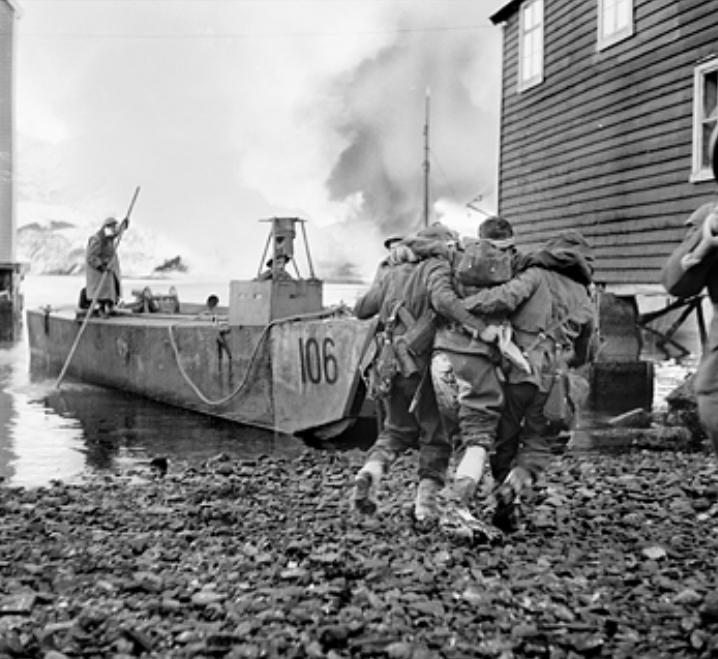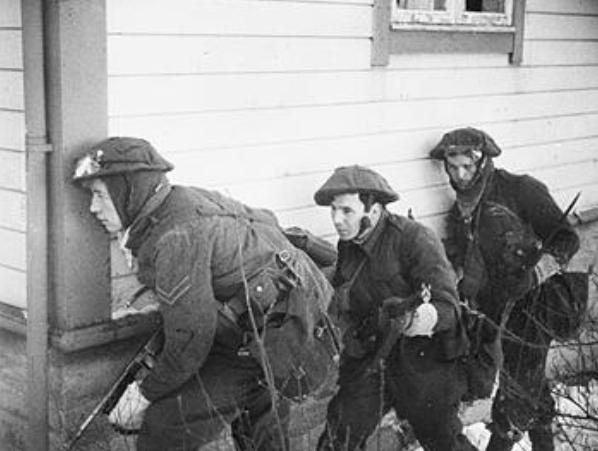Commando
British Commando Operations in Norway
On 26 and 27 December 1941, British Commando forces staged two raids on German occupied Norway. On the 26th in Operation Anklet No. 12 Commando and Norwegian Independent Company 1 landed on the Lofoten Islands as a diversionary attack for Operation Archery. As expected, the raid met little resistance as the German garrison was still busy in Christmas celebrations. On the 27th after being bombed by a German seaplane the British departed with German prisoners, Norwegian volunteers and an Enigma code machine.
On 27 December, a force of over 500 commandos staged a raid on Vaagso Island codenamed Operation Archery. Although successful, this raid met with stiff resistance due in part to 50 German Mountain troops recently arrived on leave from the Russian Front. These combat veterans provided significantly more resistance than the typical German garrison soldier. Having destroyed a number of military installations and fish oil factories (fish oil was used in explosives production), the commandos departed the same day. The raid was significant for being the first use of air, sea and land forces in a commando operation. As a direct result of this operation the garrison in Norway was increased by 30,000 men.
During the war the British Commandos conducted 12 raids against German occupied Norway; as a result, by 1944 the German garrison had been increased to 370,000 men– all soldiers who would not be engaged against forces in Normandy or the Soviet Union.

Wounded being helped onto a landing craft during the raid on Vaagso, 27 December 1941.
From the collection of the Imperial War Museum
Weapons of the British Commandos
Formed in June 1940, following a request from Prime Minister Churchill for forces that could conduct raids on German occupied Europe, British Commandos eventually formed a large number of task-oriented units mainly trained for special circumstances or geographic areas.
One thing that most of these units had in common was a selection of weapons suited to their special tasks. Raiding parties always ran the risk of being outnumbered when they landed on a raid. To offset this possible disadvantage they were typically armed with more automatic weapons than the average infantry unit. The Bren gun was their light machine gun of choice. Firing the .303in rifle cartridge at 450 rounds per minute, the Bren had effective range of 600 to 800 yards. It could be fired from the prone position with the bipod or if needed, from the hip. The Thompson submachine gun was also a very popular way of adding firepower to the raiding parties. The Model 1928 Thompson fired a .45in pistol cartridge at 600 to 725 rounds per minute with an effective range of 50 yards.
In addition to the Bren and Thompson, commandos were armed with a number of other weapons. Initially the Webley revolver was the pistol of choice, but this was replaced by the Colt 1911A1, in large measure so that pistol and submachine gun ammunition would be the same. Riflemen were armed with the Lee-Enfield.
One distinctive weapon of the commandos was the Fairbairn-Sykes fighting knife designed for close combat the knife was double edged with a metal grip.
Naturally raiding parties could be equipped with a wide range of weapons from British inventory to suit the needs of any operation.

British commandos in action during the raid on Vaagso, 27 December 1941.
From the collection of the Imperial War Museum
Post by Director of Collections and Exhibits Tom Czekanski




Leave a Reply